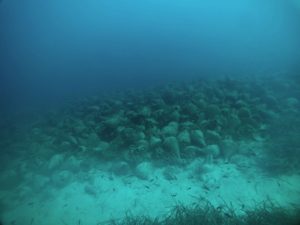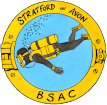It’s been ages since we could get in the water, I can’t even go to Stoney, so as soon as some restrictions were lifted I checked around to see what diving we could do. I found an old leaflet from Triton dive centre in Alonissos, where at least we could go without too much trouble with direct flights from Birmingham so I contacted them to see if we could book in.
Kostas was very helpful and suggested we might like to dive a local wreck which was opening from 3rd August until 2nd October. As far as I was concerned the earlier the better, so the compromise worked out that if we went for 2 weeks from 22nd July, we would come back on 5th August and so be able to dive the wreck on 3rd August as soon as it opened. So we packed dive gear and a supply of masks and off we went. Diving there was similar to Malta and Gozo, no corals but lots of interesting topography with caves, swim-throughs and, being a marine park, more fish life than I expected.
Kostas and the dive guides, Dias, Nicoletta and Ilyana were very enthusiastic about the wreck, it was around 2500 years old, had been discovered in the late 1980’s and archaeological teams had been surveying it since 1992. The theory before it’s discovery was that the Greeks hadn’t built ships more than around 25 metres long, but this was 75 metres long and 8 metres wide. Although the wooden ship had rotted away, the cargo of thousands of amphoras was still intact. Of course the Greeks are over the moon because they now have proof that the ancient Greeks were far more advanced than the ancient Romans!
Kostas suggested that we go to the Old Village to see the information about the ship, where they also did virtual dives with lots of information and a model of the wreck.
After a couple of days diving we were introduced to fellow divers, Petros, the Alonissos Mayor and Maria who is head of Tourism for the island, who were doing a course so they could dive the wreck. Miles and I still didn’t realise the significance of the wreck, we both assumed that it was only open for a few months each year and had been dived over the past years.
 As the days passed, the planning got more involved and the excitement built and we finally realised that the wreck would be officially opened for the first time ever on 1st August with divers coming from the Ministry of Culture, Agorastos who is the General Governor of the Region of Thessaly was there as were some Greek celebrities (who I’d never heard of), with the ceremonial cutting of the ribbon underwater. Kostas and Dias were both involved with the actual ceremony as they had been very involved with getting the wreck open to the diving community, they are both so enthusiastic about the preservation of the wreck and very keen that in the future they can open up some of the other ancient wrecks they know about in the area.
As the days passed, the planning got more involved and the excitement built and we finally realised that the wreck would be officially opened for the first time ever on 1st August with divers coming from the Ministry of Culture, Agorastos who is the General Governor of the Region of Thessaly was there as were some Greek celebrities (who I’d never heard of), with the ceremonial cutting of the ribbon underwater. Kostas and Dias were both involved with the actual ceremony as they had been very involved with getting the wreck open to the diving community, they are both so enthusiastic about the preservation of the wreck and very keen that in the future they can open up some of the other ancient wrecks they know about in the area.
Saturday evening was like a carnival, the streets were crowded with Greeks who had come to the island to be part of the historic event, and a huge screen was erected in the port area with a film of the ceremony. That was when we really understood the significance to Greece, when we heard it was international news all round the world.
On Monday 3rd the wreck was open to recreational divers for the first time ever. As Triton Dive centre were so involved with the opening, they were able to book the first dive slot so, at 10.00 we went to see the archaeological team who vetted the divers, we had to be well qualified and Kostas, Dias and Ilyana were responsible for confirming that our buoyancy was good enough to not damage anything. Crashing down onto those amphoras after 2500 years of preservation was not an option! We then went to the wreck for our timed slot of 10.30.
There are 5 cameras stationed around the wreck and we had to stay 1 metre away from the edge and 2 metres above the seabed. Dias and Ilyana had both been passed as guides, they will only allow a few designated guides to take divers on the site. The Greek Government are really taking the care of this important site very seriously.
The sheer volume of cargo was staggering and most of it was still intact. There were a few yellow signs dotted about to differentiate the amphoras, 2 different designs and another design of jug with a flat bottom. A couple of the archaeological team were still working on the site and we were treated to a demonstration of how they brought some of the cargo to the surface, checked it over and then returned it to its original position.
The dive lasted over 45 minutes and we only went round the wreck, but it was brilliant, with visibility meaning we could see all the wreck as we came up from the bottom, back up the shot line.
It was fantastic to be in at the start of such an important event, I think the god Poseidon was looking out for us when we decided to go diving again, we’ll probably never get another opportunity like that again.
Hilary






